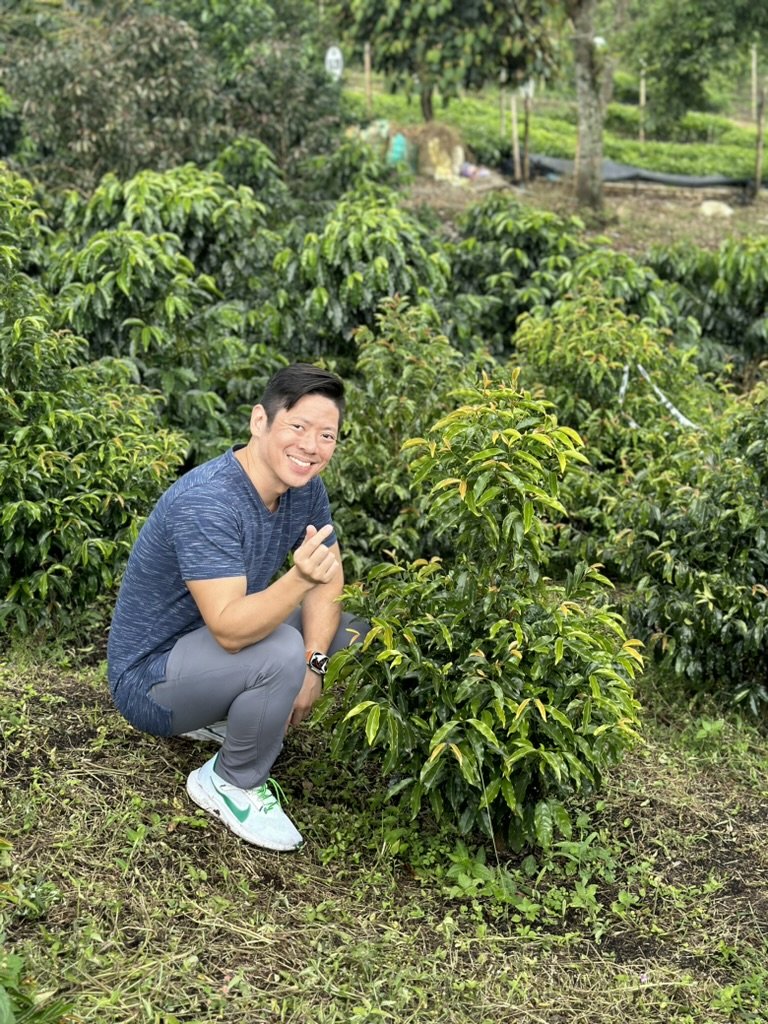The Journey to an Exceptional Cup of Coffee - Part 2 the Varietal
Varietal – The Choice of Coffee Plant and Its Impact on Flavor
When people think of coffee, they often picture the fragrant aroma, the comforting warmth of the coffee as they take a sip and the expotion of soothing flavors as they take their morning cup, or perhaps even lush haciendas filled with vibrant greens and the promise of ripe coffee cherries. However, one of the biggest influences on that experience is often overlooked—the choice of coffee species and varietal. Over the years, I’ve had the privilege of traveling to some of the world’s most remarkable coffee-growing regions, from the famed Gesha Village in Ethiopia, the lush highlands of Dalat in Vietnam to the distinct landscapes of Benguet, Batangas, and Laguna in the Philippines. Each of these regions, including Wilton Benitez’s Ganja Parasio in Colombia, is home to unique species and varietals, each contributing its own distinct character to the coffee.
Gesha Village - Ethiopia
In my journeys, I’ve come to appreciate how the choice of species—and the varietals within those species—shapes the flavors, body, and aroma of each bean. While species set the fundamental characteristics, varietals bring layers of complexity, creating a vast range of flavors and experiences. For instance, the floral, delicate notes of the Gesha varietal in Ethiopia stand in striking contrast to the rich, chocolatey tones of Vietnamese Robusta or the vibrant, fruity profiles found on farms in Colombia.
The elusive Eugenioides species
During a recent exploration with Wilton Benitez in Colombia, I gained deeper insight into the art of varietal selection. Wilton’s approach combines science and intuition, carefully matching coffee plants with specific microclimates that allow each varietal to thrive. Wilton’s farm is a living archive of coffee diversity, where he cultivates a collection of over 32 different Arabica varietals, as well as the rare and elusive Eugenioides species—a coffee species once believed extinct and recently revived. This intentional selection and preservation are vital for producing a coffee that is not only complex and balanced but also unforgettable, offering flavors as unique as the plants themselves.
In this part of our series, I’ll guide you through the fascinating world of coffee species and varietals. We’ll explore how each impacts flavor and why these choices matter—not only to the farmers and roasters but to anyone who values an extraordinary cup of coffee. Join me as we uncover how these selections unlock the full potential of every coffee bean, elevating each sip into a unique experience.
To understand the world of coffee, it’s essential to first distinguish between species and varietals. Coffee plants are primarily classified into species, with the most well-known being Arabica (Coffea arabica), Robusta (Coffea canephora), and the less common Liberica (Coffea liberica). Each species brings distinct characteristics to the cup: Arabica is celebrated for its nuanced acidity and complex flavors; Robusta offers a stronger, more bitter profile with higher caffeine content; and Liberica has a unique, fruity taste with a heavier body and the lowest caffeine content of the three.
Within each species, there are varietals—specific cultivars or genetic variations of the species, such as Typica, Bourbon, Caturra, and Geisha within Arabica. These varietals further enhance and diversify coffee’s flavor by contributing unique qualities that are specific to each type. While species set the foundational traits of a coffee’s flavor, varietals add layers of complexity, creating a vast range of flavors and experiences even within the same species.
How Different Varietals Impact Acidity, Body, Sweetness, and Aroma
1. Acidity: Varietals influence the acidity, or brightness, in coffee, adding sharpness or subtlety to the flavor profile. For example, Geisha, a prized varietal that originated from Ethiopia, is known for its high acidity, often with a citrusy, tea-like brightness. In contrast, Bourbon varietals present more balanced acidity, offering a mild fruitiness that complements rather than dominates.
2. Body: The body of a coffee—its texture and mouthfeel—also varies across varietals. Typica generally provides a medium body, offering a smooth, refined experience. Meanwhile, Pacamara varietals from Central America deliver a heavier, syrupy body, adding richness that lingers on the palate.
3. Sweetness: Many varietals contribute specific sweetness levels, ranging from subtle honey to bold caramel. For instance, Caturra is known for its natural sweetness, often with brown sugar and cocoa undertones, balanced by mild acidity. Another example, SL28 (a Kenyan varietal), often has a fruity sweetness reminiscent of berries, enhancing the cup’s depth and vibrancy.
4. Aroma: Aroma is another dimension deeply affected by varietal, with each type carrying its own fragrance. Geisha, for instance, has a signature floral aroma with notes of jasmine, orange blossoms and bergamot, giving it a tea-like quality. In comparison, Bourbon varietals tend to carry nutty, sweet aromas that pair well with their smooth, balanced flavors.
Examples of Popular Coffee Varietals and Their Distinct Flavor Notes
• Bourbon: With balanced acidity and a smooth body, Bourbon varietals are celebrated for their caramel, chocolate, and soft fruit notes, creating a comforting, approachable cup.
• Typica: Known for its clean, bright acidity and medium body, Typica has a refined sweetness and delicate fruit and floral notes, lending an elegant touch to the coffee.
• Geisha: Prized for its extraordinary complexity, Geisha varietals have high acidity, a light body, and floral, tea-like aromas. Tasting notes often include jasmine, bergamot, and tropical fruit, making it one of the most distinctive coffees globally.
• Caturra: Compact and high-yield, Caturra offers bright acidity and a natural sweetness, with notes of citrus, brown sugar, and cocoa, creating a vibrant yet balanced cup.
• SL28: Developed in Kenya, SL28 is celebrated for its vibrant acidity, full body, and rich sweetness, often with blackcurrant, berry, and tomato notes that reflect the terroir of East Africa.
Together, these varietals offer a spectrum of flavors and experiences, demonstrating the rich diversity that coffee brings. By selecting different varietals, coffee growers and roasters can create distinct profiles that highlight each coffee’s unique character and origin. Through this diversity, coffee becomes not just a drink but a journey of flavors, aromas, and textures, each cup telling a story of the varietal from which it was crafted.
Wilton Benitez’s Insights on Varietal Selection
One of the most enlightening aspects of my visit to Colombia was witnessing Wilton Benitez’s expertise on varietal selection. His approach is rooted in a deep understanding of how each type of coffee plant interacts with its environment, combining science with intuition to make these decisions. Wilton begins by sending each varietal to specialized laboratories to analyze its natural volatile aroma compounds, helping him identify and amplify the most desirable flavor attributes. Based on these insights, he carefully selects the ideal elevation and microclimate within his vast property to bring out the best in each varietal.
Wilton doesn’t merely choose varietals for their reputation; he meticulously matches each one to the precise terroir where it will thrive. His farm is a testament to this approach, with over 32 different varietals strategically positioned across the landscape. By carefully considering factors like altitude, temperature, and soil composition, he ensures that each varietal reaches its full potential in flavor and complexity. This tailored positioning creates an optimal environment for each plant, allowing Wilton to produce a truly exceptional coffee experience in every cup.
Impact of Varietals on Coffee Quality and Consistency
The choice of varietal plays a significant role in determining not only the flavor but also the quality and consistency of the coffee crop. Certain varietals are known for their resilience and adaptability to specific climates, while others may be more delicate but offer richer flavors. For instance, high-yield varietals like Caturra and Catimor provide consistent production and are more resilient to disease, making them advantageous for farmers. However, the challenge lies in balancing varietal purity and hybridization. Pure varietals like Typica and Bourbon offer unique flavor profiles but may lack resistance to disease, whereas hybrids may offer enhanced resilience but sometimes at the cost of unique flavor notes that is sought after by the specialty coffee community. Maintaining varietal purity can ensure consistency in flavor, but hybridization offers benefits in crop resilience, making it a complex yet rewarding decision for coffee producers.
Sustainability and Varietal Cultivation
In the pursuit of sustainable coffee farming, selecting varietals that are suited to specific regions is essential. Growing varietals adapted to the local environment reduces the need for intensive resources, such as water and fertilizers, thereby promoting sustainability. At Henry & Sons, we prioritize supporting local farmers in choosing and cultivating varietals that suit their region’s natural conditions, enabling more sustainable and resilient coffee production. Through partnerships and our Foundation for Sustainable Coffee Excellence (FSCE), we work closely with farmers in the Philippines and beyond to cultivate varietals that contribute to both environmental health and the economic stability of coffee-growing communities.
The Consumer Experience: Tasting Varietal Differences
For coffee lovers, understanding and tasting the differences between varietals can open up a new world of flavor discovery. Each varietal has distinct tasting notes and aromas that can be appreciated through mindful tasting. For example:
• Bourbon: Known for its balanced sweetness and smooth body, with notes of caramel and chocolate.
• Geisha: Offers bright acidity and a floral aroma, with notes of jasmine and bergamot.
• SL28: Known for its vibrant acidity and fruity notes, often reminiscent of berries or blackcurrants.
• Typica: One of the oldest and most widely cultivated varietals, Typica has a clean, bright acidity with a smooth body and subtle sweetness, often featuring delicate notes of fruit and floral undertones.
To experience these differences firsthand, you can visit The Giving Café or join our monthly public cupping sessions at Henry & Sons. Each event is an opportunity to explore the unique flavors of various varietals and deepen your appreciation for the craft behind every cup.
The Journey Continues – Teaser for Part 3: Climate
As we wrap up our exploration of varietals, it’s clear that the choice of coffee plant has a profound impact on the flavor, quality, and sustainability of coffee. Each varietal tells a story of coffee’s natural evolution and the careful cultivation it has received. In the next part of this series, we’ll dive into the role of climate—another powerful factor in coffee quality. From altitude to rainfall, we’ll explore how the environment shapes the beans, contributing to the diverse flavors and aromas that make coffee so extraordinary.
If you’re ready to explore the world of coffee like never before, treat yourself to the unique flavors of our varietal-specific coffees available on The Vault, Henry & Sons Shopee, and Lazada stores. Each cup offers a journey into the rich diversity of coffee, allowing you to savor exceptional flavors and aromas right at home. Plus, with every purchase, you’re supporting sustainable coffee farming in the Philippines, ensuring that each sip contributes to a beautiful coffee future.
Read Part 1 The Soil The Journey to an Exceptional Cup of Coffee
Read Part 3 The Climate The Journey to an Exceptional Cup of Coffee





